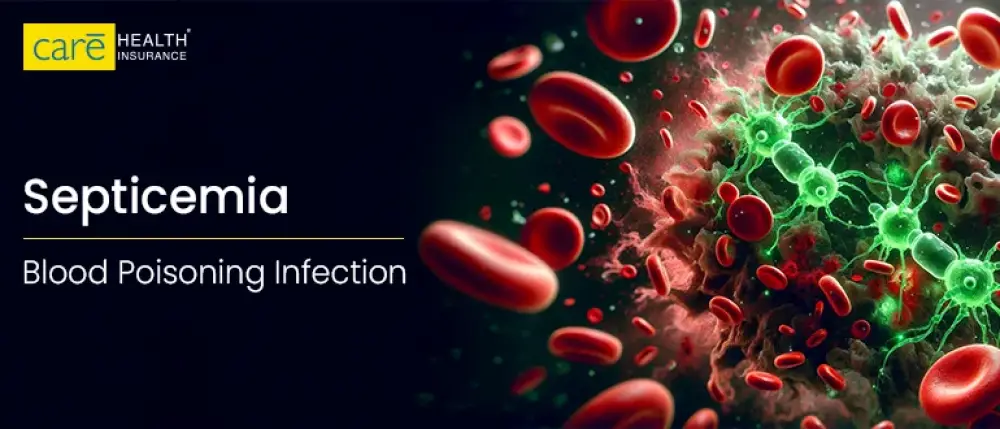Subscribe to get weekly insights
Always stay up to date with our newest articles sent direct to your inbox
Published on 5 Aug, 2025
Updated on 22 Nov, 2025
387 Views
3 min Read

Written by Sejal Singhania
Reviewed by Akhil Pillai
favorite2Likes
Imagine a small wound or a urinary infection unexpectedly becoming life-threatening in just a few hours. While this might sound scary, it's important to understand how septicemia works. It can begin quietly, like a minor infection, but if left untreated, it can pose serious risks.
Septicemia can take over your bloodstream if left untreated, turning your body into a battleground. In this blog, we’ll explore septicemia's meaning, how it progresses, its warning signs, and how you can protect yourself from it. Let's take a closer look at this silent and powerful storm happening inside our bodies.
Septicemia, often known as blood poisoning, is a severe bloodstream infection. It happens when bacteria from other parts of the body, such as the skin, lungs, kidneys, or bladder, enter the bloodstream. While bacteria are the common cause, viruses and fungi can also be responsible. This condition is dangerous because bacteria and their toxins can spread throughout the body via the bloodstream. It can rapidly become life-threatening, requiring hospitalisation for treatment.
If not treated promptly, septicemia can develop into sepsis, a life-threatening condition where your body starts attacking its tissues and organs.
Almost any germ can lead to septicemia. The most common culprits are bacteria, which include:
Septicemia symptoms can resemble the flu, but they appear suddenly and are more severe. Common signs of septicemia may include:
Septicemia doesn't occur on its own; it typically arises from another infection in your body that spreads. Some common causes of septicemia include:
Septicemia can affect anyone, but it is more frequently seen in individuals who:
Many individuals often confuse sepsis and septicemia, believing them to be the same. While closely connected, they are distinct conditions. Here’s a comparison between sepsis and septicemia to understand the differences between them:
| Aspects | Septicemia | Sepsis |
|---|---|---|
| Definition | Occurs when bacteria invade the bloodstream, leading to blood poisoning. | Sepsis is a severe and life-threatening reaction to infection that may cause tissue damage, organ failure, and death. |
| Stage | Often an early stage of systemic infection. | More advanced stage following septicemia. |
| Symptoms | Fever, chill, rapid heartbeat. | Confusion, low BP, and organ problems. |
| Severity | Serious but treatable if caught early. | Very serious, can be life-threatening. |
The doctor will evaluate the patient's history and conduct a physical exam to identify the likely infection site. Further tests include:
Septicemia needs urgent treatment, primarily with antibiotics and supportive care, to manage the infection and its consequences. The goal of treatment is to find and remove the source of the infection, fight the bacteria, and assist vital organ function. Common treatments for septicemia include:
Bonus Tip: Treating septicemia usually requires urgent hospitalisation, intensive care, and powerful antibiotics, all of which can be expensive. This is where reliable medical insurance becomes valuable. It guarantees quick access to quality treatment and protects you from the worry of unexpected medical expenses. Opt for the Critical Illness Policy from Care Health Insurance to help you remain financially stable during health emergencies like septicemia.
You can reduce the risk of septicemia by:
Septicaemia shouldn't lead to panic, but it does need immediate action. By being aware, seeking prompt medical help, and taking preventive measures, you can avoid serious complications. It's important to listen to your body and never ignore signs of infection. Early identification and treatment are key to effective septicemia management. Even minor infections should be taken seriously as a vital preventive step.
>>Read More: Everything About Sepsis Infection, Its Symptoms, Causes, and Treatment
Disclaimer: The above information is for reference purposes only. Kindly consult your general physician for verified medical advice. Health insurance benefits are subject to policy terms and conditions. See policy documents for details.
Thyroid : मामूली नहीं हैं महिलाओं में थायराइड होना, जानें इसके लक्षण और घरेलू उपचार Vipul Tiwary in Diseases
शुगर कंट्रोल कैसे करे? जानें, डायबिटीज में क्या खाना चाहिए Vipul Tiwary in Health & Wellness
हाई ब्लड प्रेशर को तुरंत कंट्रोल कैसे करें? देखें इसके उपाय Vipul Tiwary in Diseases
पैरों में दर्द किस कमी से होता है? जानें, इसके घरेलू इलाज Vipul Tiwary in Health Insurance Articles
Nutritionist vs. Dietitian: Same Same… but Different! Leena Khowal in Health & Wellness
Silent Epidemic: Fatty Liver Disease Now Targeting the Young! Jagriti Chakraborty in Health Insurance Articles
Iodine Rich Foods: The Unsung Heroes of a Healthy Thyroid and a Sharp Mind Jagriti Chakraborty in Diet & Nutrition
Honey, Jaggery & Sugar: Which Sweetener Wins? Jagriti Chakraborty in Health & Wellness
Early symptoms of septicemia in adults and older children include fever, rapid heartbeat, vomiting, headache, and others.
Septicemia is a life-threatening infection caused by bacteria, viruses, or fungi entering the bloodstream and spreading throughout the body.
Sepsis is your body's extreme response to infection, also known as septicemia, which is blood poisoning by bacteria, viruses, or fungi.
Yes, septicemia, or blood poisoning, can be treated successfully with prompt, intensive care. While mild cases heal quickly, severe ones may require extended hospitalisation and could cause long-term effects.
Septicemia can advance to septic shock. This results in a significant decrease in blood pressure, which can harm the lungs, kidneys, liver, and other organs. If the damage is serious, it may cause death.
Sepsis can lead to organ failure, often beginning with the kidneys. This condition can also cause a dangerous drop in blood pressure.
Always stay up to date with our newest articles sent direct to your inbox
Loading...